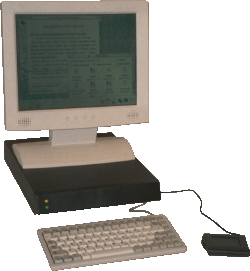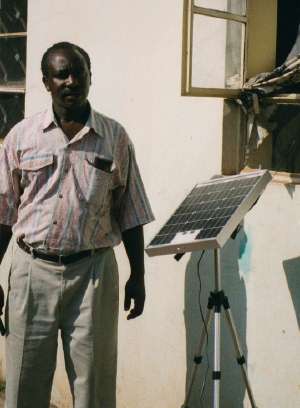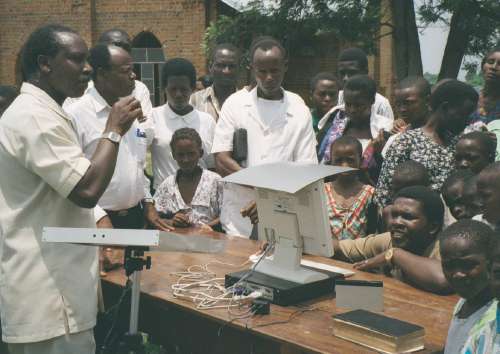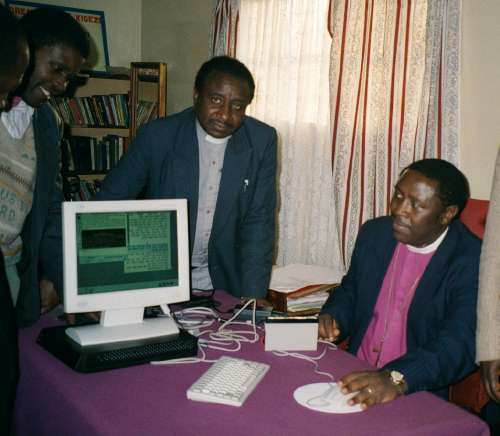Page index:
Links back:
![]()

RISCOS Solo
Transportable computer
A new ruggedised RISCOS computer, the Solo is intended for use within Third-world countries where its ultra-low-power design enables it to be used indefinitely away from sources of mains electricity.
See also the ![]() new Solo pages with pictures of the Mk II prototype.
new Solo pages with pictures of the Mk II prototype.
 |
Solo prototype:shown with 13.3" TFT LCD panel at XGA resolution (1024x768).The mouse is replaced by a 3-button touch-pad to avoid malfunctioning due to ingress of red African dust. The miniature keyboard measures 280x130mm and provides 83 keys. |
Click here to display a larger (135k) GIF image of this graphic
Solo is a transportable rather than a portable computer. It is designed for ease of relocation within harsh and demanding environments, and may be supplied in a variety of configurations and screen sizes.
The production units will be a single-box design with the LCD screen in front of the computer motherboard. The entire device will be solid state,
incorporating a derivation of RISCOS in ROM, applications in Flash RAM and the usual RAM for workspace.
Low Power requirements

The prototype Solo uses a meagre 17 Watts of power including the LCD screen, but despite employing a small disc drive unit and using a power-hungry analogue-signal driven monitor, which squanders a further 5 Watts.
The final design of Solo will use a digital screen interface and is expected to draw only 8.5 Watts including other power-saving refinements. These will permit it to be run from a single 10W solar panel, and still leave a little spare to charge a battery.
Other power sources tested so far include:-
- Mains power-pack (15v DC)
- 12 volt 2 Amp/hour lead-acid battery in belt-pouch
- Car cigar-lighter socket
- 24v vehicle battery via croc-clips
Solo - the Green computer
At 81/2 Watts, Solo's power supply requirements compare favourably with a full desktop RISCOS computer, the lowest powered unit currently being the RiscStation, which draws about 40 Watts including hard-disc and CD (plus screen, which is integral on the Solo). Even this is minute compared with a typical full Pentium PC system (incl monitor) at around 500 W.
The Solo complies with the aspirations of the signatories of the Earth Summit in Rio, 1992, which pledged the greater use of sustainable energy sources. Agenda 21 was the significant outcome of the Rio Summit which created a global action-plan to reduce global warming and promote bio-diversity.
Whilst many Western countries have yet to comply with their obligations under the Agenda 21 agreement, the lack of sufficient power to run thirsty IT equipment is a serious brake on technological development in developing countries. Solo will alleviate this restriction, whilst simultaneously permitting complience with Agenda 21 on the part of the Developing World.
However, as this page is written, large parts of Silicon Valley in the USA are under rolling power-cuts due to their inability to provide sufficient electricity to power the air-conditioning required to extract the excess heat from their PC-equipped offices!
Further information on this topic can be obtained from the UN Forum on Environment and Development ![]() UNED, or the UK site on the implementation of Agenda21 at
UNED, or the UK site on the implementation of Agenda21 at
![]() Project PlanetEye which is constructed on Eco-friendly RISCOS computers!
Project PlanetEye which is constructed on Eco-friendly RISCOS computers!
Other energy efficient products on this site include ![]() LCD monitors
for desktop computers, and
LCD monitors
for desktop computers, and ![]() Laser Printers with low running costs and eco-friendly toner.
Laser Printers with low running costs and eco-friendly toner.
Display options
Solo will be offered with a number of different LCD display options. These are expected to include:-
- 8" SVGA (800x600)
- 13.1" SVGA (800x600)
- 13.3" XGA (1024x768)
- 15" XGA (1024x768)
Touch-screen. It is likely that some models will be supplied with optional touch-screen technology, which will display an on-screen
keyboard if one is not already plugged into the main unit.

The Solo prototype being admired at a village near Kihihi, 80km south of the Equator. Notice the solar panel in the
foreground pointing almost directly up as it is 20 days before the equinox at 1pm!
The thin lead-acid belt-pack battery is visible
to the right of the Solo. It is usually being trickle-charged, but also provides sustained power when an over-inquisitive hand is
waved across the solar panel.
Click here to display a larger (130k) JPEG image of this graphic
Target Market
The Solo is intended to be used primarily by personnel working for organisations in remote regions, possibly village schools, missionary stations and clinics. It will also be of value to agriculturalists, health workers and NGO's who must remain away from their base for indefinable periods.
Documents may be written using the inbuilt word-processor, which will be Microsoft Word compatible. Emails can be constructed and stored in a queue.
As required, the Solo can be taken into a town with telephone access, where it can transfer emails across the Internet, and be connected to a desktop computer for the transfer of files and sharing access to a printer using an inbuilt utility.

Solo prototype being evaluated by Bishop George of Kigezi, Southern Uganda, and his Diocesan Planning Team.
Click here to display a larger (148k) JPEG image of this graphic
Specifications
Solo is intended to be built by companies created for that purpose in Developing Countries. As such the exact specifications and range of options will remain the decision of each licensed manufacturer.
However guideline specifications are as follows:-
| Prototype | Production unit | ||
| Processor | ARM-7500 | ARM-7500 | |
| Operating system; | RISCOS 4.03 in 4Mb ROM | RISCOS 4* in 5Mb ROM | |
| Memory; | 16Mb + 750Mb hard-disc | 16 Mb RAM, plus 128Mb or 256Mb Compact Flash RAM | |
| Display options; | Analogue 13.3" TFT LCD | Digital 8", 13" or 15" LCD with touch-screen option | |
| Power supply; | 12-30v DC at 17 Watts | 6-40v DC at 81/2 Watts, and inbuilt cache battery | |
| Weight; | 15Kg incl batteries, solar panels and tripod in briefcase | < 8Kg | |
| Ports; | Video, parallel, serial, keyboard, mouse, 10baseT Ethernet | As prototype, plus USB, and optional built-in modem |
The rectangular casing used will differ between manufacturers. However initial discussions in Africa have suggested a carved wooden surround. This unit will not be required to
pass EC electro-magnetic radiation tests, although emissions are known to be very low. Real-ivory keyboards are not an option!
Pricing
Intial costings suggest a base price commencing at $1000 (US) including basic RISCOS applications together with a word-processor (MS Word compatible), and a full internet suite.
For use in missionary work, ExpLAN will licence a copy of its ![]() HolyBible
application, for which modules already exist
in
HolyBible
application, for which modules already exist
in ![]() Kinyarwandan and Swahili.
Kinyarwandan and Swahili.
Projected release date Qtr 3 2002, subject to satisfactory conclusion of negotiations for manufacturing licences with companies in the Developing World. Enquiries at this stage should be limited to potential manufacturers, Government representatives, NGO's, media and organisations required to achieve complience with Agenda 21 only.
Contact details for ExpLAN Computers Ltd can be found on the ![]() ExpLAN homepage.
ExpLAN homepage.